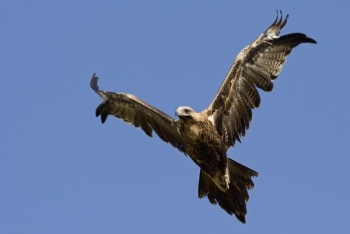(Category:Aquila) |
(→External Links: New combined GSearch. GSearch checked template) |
||
| (17 intermediate revisions by 7 users not shown) | |||
| Line 1: | Line 1: | ||
| + | [[Image:Wedge-tailed-Eagle-7919W.jpg|thumb|550px|right|Photo © by '''[http://www.birdforum.net/member.php?u=49168 Hans&Judy Beste]'''<br />Longreach district, [[Queensland]], April 2014]] | ||
;[[:Category:Aquila|Aquila]] audax | ;[[:Category:Aquila|Aquila]] audax | ||
| − | [[Image:Wedge- | + | |
| − | + | ==Identification== | |
| − | Australia's largest eagle. | + | [[Image:Eagle, Wedge-tailed 04kk Aquila audax AUSTRALIA.jpg|thumb|350px|right|Juvenile<br />Photo © by {{user|peterday|peterday}}<br />Naracoorte, [[South Australia]], December 2014]] |
| + | 81–104 cm (32-50 in); Australia's largest eagle. <br /> | ||
Long wings with long primaries can span from 2 to 2.5 metres. | Long wings with long primaries can span from 2 to 2.5 metres. | ||
Males smaller than females. | Males smaller than females. | ||
| − | + | <br /> | |
Young birds are light brown becoming darker with age until almost all black for the most mature adults. | Young birds are light brown becoming darker with age until almost all black for the most mature adults. | ||
| − | + | ====Similar Species==== | |
| − | Immatures can be confused with immature [[White-bellied Sea | + | Immatures can be confused with immature [[White-bellied Sea Eagle]] ''Haliaeetus leucogaster'' which has a much shorter wedge-shaped tail. |
==Distribution== | ==Distribution== | ||
| − | [[Australia]]: occurs almost throughout the continent and on Tasmania, also in southern [[New Guinea]] | + | [[Australia]]: occurs almost throughout the continent and on [[Tasmania]], also in southern [[New Guinea]]. |
==Taxonomy== | ==Taxonomy== | ||
| − | Subspecies: | + | [[Image:Wedge-tailed_Eagle.jpg|thumb|350px|right|Photo © by {{user|stoop|stoop}}<br />South-eastern [[Queensland]], [[Australia]]]] |
| + | ====Subspecies==== | ||
| + | There are 2 subspecies <sup>[[#References|[1]]]</sup>: | ||
| + | *''A. a. audax'': | ||
| + | :*Plains, deserts, open woodlands of [[Australia]] and southern [[New Guinea]] | ||
| + | *''A. a. fleayi'': | ||
| + | :*[[Tasmania]] | ||
==Habitat== | ==Habitat== | ||
Dry open plains to mountain forests. Nests in trees or sometimes on the ground on islands | Dry open plains to mountain forests. Nests in trees or sometimes on the ground on islands | ||
==Behaviour== | ==Behaviour== | ||
| + | [[Image:Wedge-tailed eagle imm.jpg|thumb|350px|right|Immature<br />Photo © by '''[http://www.birdforum.net/member.php?u=16212 Mat & Cathy]'''<br />Oxley Creek Common, Brisbane, SE [[Queensland]], [[Australia]], October 2009]] | ||
| + | ====Flight==== | ||
| + | Long 'wedge' or diamond-shaped tail and long wings and primaries are most obvious when soaring. | ||
| + | ====Diet==== | ||
Preys on mammals, large birds and large reptiles (such as snakes and goannas). Can be encountered feeding on road-killed animals in country areas. | Preys on mammals, large birds and large reptiles (such as snakes and goannas). Can be encountered feeding on road-killed animals in country areas. | ||
| + | ====Movements==== | ||
| + | Resident and nomadic. | ||
| + | ====Vocalisation==== | ||
| + | '''Call''': a thin high-pitched whistle given in flight. | ||
| + | ==References== | ||
| + | #{{Ref-Clements6thAug17}}#Handbook of the Birds of the World Alive (retrieved April 2015) | ||
| + | {{ref}} | ||
==External Links== | ==External Links== | ||
| − | {{GSearch|Aquila | + | {{GSearch|"Aquila audax" {{!}} "Wedge-tailed Eagle"}} |
| + | {{GS-checked}}1 | ||
| + | <br /> | ||
| + | <br /> | ||
| − | |||
[[Category:Birds]] [[Category:Aquila]] | [[Category:Birds]] [[Category:Aquila]] | ||
Latest revision as of 20:55, 11 May 2023
- Aquila audax
Identification
81–104 cm (32-50 in); Australia's largest eagle.
Long wings with long primaries can span from 2 to 2.5 metres.
Males smaller than females.
Young birds are light brown becoming darker with age until almost all black for the most mature adults.
Similar Species
Immatures can be confused with immature White-bellied Sea Eagle Haliaeetus leucogaster which has a much shorter wedge-shaped tail.
Distribution
Australia: occurs almost throughout the continent and on Tasmania, also in southern New Guinea.
Taxonomy
Subspecies
There are 2 subspecies [1]:
- A. a. audax:
- Plains, deserts, open woodlands of Australia and southern New Guinea
- A. a. fleayi:
Habitat
Dry open plains to mountain forests. Nests in trees or sometimes on the ground on islands
Behaviour
Flight
Long 'wedge' or diamond-shaped tail and long wings and primaries are most obvious when soaring.
Diet
Preys on mammals, large birds and large reptiles (such as snakes and goannas). Can be encountered feeding on road-killed animals in country areas.
Movements
Resident and nomadic.
Vocalisation
Call: a thin high-pitched whistle given in flight.
References
- Clements, J. F., T. S. Schulenberg, M. J. Iliff, D. Roberson, T. A. Fredericks, B. L. Sullivan, and C. L. Wood. 2017. The eBird/Clements checklist of birds of the world: v2017, with updates to August 2017. Downloaded from http://www.birds.cornell.edu/clementschecklist/download/
- Handbook of the Birds of the World Alive (retrieved April 2015)
Recommended Citation
- BirdForum Opus contributors. (2024) Wedge-tailed Eagle. In: BirdForum, the forum for wild birds and birding. Retrieved 22 May 2024 from https://www.birdforum.net/opus/Wedge-tailed_Eagle
External Links
GSearch checked for 2020 platform.1







